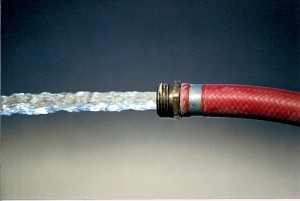
Blood should flow through an artery like water through a hose. The stress of a blockage can encourage clots to form, potentially resulting in a heart attack or stroke. Donald Ingber thinks the same forces could be used to help dissolve clots. (Beth Kingery/Flickr)
Grab a garden hose. Put your thumb over the end, but not all the way, and turn the water on. What happens? The water coming out of the hose gets squeezed as it tries to push past your thumb, putting a lot of force on the molecules in the water and making a big spray.
Now do the same thing with an artery: Partially block it with a clot and let blood flow through it. In this case, the force you’ve created in the artery could be lethal—creating fertile ground for blood clots that could lead to a stroke or heart attack.
But what if that combination of force and pressure could be used to stop something like a stroke instead? What if it could release a clot-dissolving drug on the spot? Donald Ingber, MD, PhD, a member of Boston Children’s Hospital’s Vascular Biology Program, had wondered that for many years. To find out, Ingber, who also directs the Wyss Institute for Biologically Inspired Engineering at Harvard, had his team start with a simple question: How do clots form? Full story »







